
|
|

February 12, 2010
More Sites Around Washington, DC, 2008
Welcome to the next-to-last installment in a multi-segment recap of a fun trip we took in the summer of 2008, wherein Ari (then not quite five years old) had her first visit to Washington. Somewhere amidst the White House and Capitol and Air & Space Museum and all the other tourist offerings, we managed (coincidentally, I swear!) to drive by a lot of Washington's tower sites, and in this week's installment we profile a few of them.
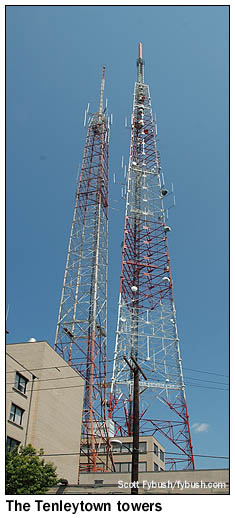
|
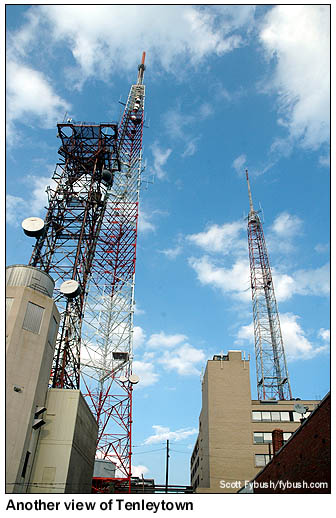
|
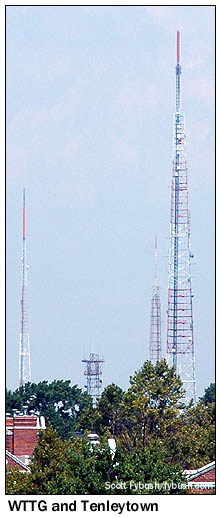 |
As it happened, our route into downtown Washington from our lodgings in the far northwest corner of the District took us right down Wisconsin Avenue, past the towers that carry most of Washington's TV stations from atop some of the highest elevations in the city.
The Tenleytown neighborhood is Washington's very highest spot, and it was home to a TV tower as early as 1949, when Bamberger Broadcasting Service (which also owned WOR and WOR-TV in New York) put WOIC-TV (Channel 9) on the air from a 300-foot self-supporting tower near the corner of Wisconsin Avenue and Brandywine Street. Two years later, the station had been sold to a partnership of the Washington Post and CBS, which changed the calls to WTOP-TV and began drawing up plans for a massive new studio/office facility adjacent to the tower. Broadcast House opened in 1953 and remained in use until 1992, when channel 9 (by now WUSA-TV) moved to a new Broadcast House a few blocks down Wisconsin. WTOP radio moved out of Broadcast House when it was sold in the late seventies; it took up residence around the corner in an office building on 40th Street before moving to its present home on Idaho Avenue in the late eighties.
(My friend and fellow broadcast historian James O'Neal has a wonderful article in the latest issue of Radio World about the construction of Broadcast House and the unusual WTOP-FM 96.3 antenna that was erected inside the top of the TV tower.)
Even as Tenleytown ceased to be a studio location (with the exception of public broadcaster WAMU, which is located in an American University office building right across Brandywine from the old Broadcast House, which has been renovated and converted into a health club), it became ever more important as a transmitter site. A 640-foot self-supporting tower went up in 1972 next to the original Channel 9 tower, providing antenna space for channel 9 as well as Washington's ABC affiliate, WMAL-TV (later WJLA) channel 7, which moved to Tenleytown from its original site on the American University campus. (Ironically, that tower at AU remains home to WAMU, and is now home to WTOP's current FM incarnation on 103.5 as well.)
The Tenleytown tower had several FM tenants as well: Howard University's WHUR (96.3), the former WTOP-FM, and channel 7's sister station WMAL-FM (107.3), later WRQX. Later on, a third station, WASH (97.1), would be added to the Tenleytown facility.
With the arrival of digital TV, the Tenleytown tower added still more tenants: public broadcasters WETA-DT (RF 27/virtual 26) and WHUT (RF 33/virtual 32) and Pax's WPXW (RF 34/virtual 66) have joined WUSA (channel 9) and WJLA (RF 39/virtual 7) on the tower.
(There was another tower here, too, albeit only briefly: American Tower fought a long, nasty legal battle to complete construction of a 756-foot tower on the site of a former Western Union microwave facility next to the existing Tenleytown towers. The tower was more than halfway completed by the time a settlement was reached in 2006, and the unfinished tower was subsequently removed.)
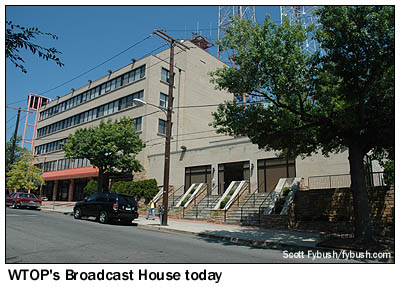
|
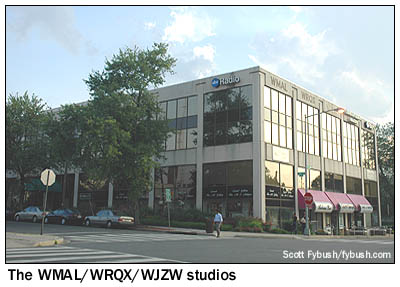 |
It's just a few alphabetical blocks north on Wisconsin from Brandywine to Garrison Street, where we find another tall tower next to a studio building. 5151 Wisconsin Avenue is the longtime home of Washington's Channel 5, WTTG, which was part of the original DuMont station group (its calls stand for Allen B. DuMont's right-hand man, Thomas T. Goldsmith, who died just last year at age 99.) It built its present facility in 1963 when the station was under Metromedia ownership, and for many years WASH (97.1) was a sister station to WTTG, sharing the studio building and the 705-foot tower out back.
WASH has since changed hands and moved to Tenleytown, and in the meantime WTTG became a core part of the Fox Television Stations group. Fox added a second signal to its Washington holdings as well: independent WDCA (Channel 20) became first a UPN and then a My Network affiliate, and WDCA-DT (RF 35) now shares the studios and the Wisconsin Avenue tower with WTTG-DT (RF 36).
Three more blocks up Wisconsin brings us to Jenifer Street, and it's at 4400 Jenifer that we see the office building where Citadel's stations, the former ABC Radio group, are housed. WMAL (630) is the flagship, accompanied by WRQX (107.3) and a third FM that was oldies WJZW (105.9 Woodbridge VA) when we drove by in 2008, but has since become rocker WVRX.
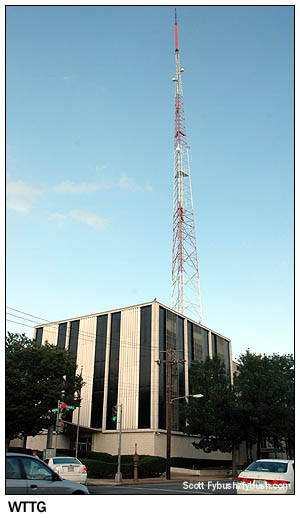
|
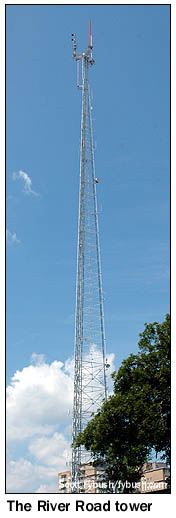
|

|
The Jenifer Street studios are just a couple of blocks from Western Avenue, which marks the boundary between the District and Maryland, and it's just a few blocks down Western to River Road, one of the main arteries into Bethesda, Maryland. Only about half a mile past the District line is the last of the TV towers we'll see today: the 809-foot tower that was built in 1965 for WDCA, channel 20 and WETA, channel 26. WDCA's studios were in a building right next to the tower, which eventually also became home to WHUT, channel 32.
The end of analog TV also marked the end of television on this tower, but it remains in use for FM. That's CBS Radio's Bethesda-licensed 94.7 (it was WTGB in 2008, and is now "Fresh FM" WIAD) on the two-bay ERI at the top, with Clear Channel's WIHT ("Hot 99.5") on the panel antenna just below it.

|

|
Continuing to the northwest on River Road eventually brings us to the Beltway (I-495), but before we get on the Beltway and start heading for home, we make one more turnoff down Burdette Road, into a ritzy neighborhood of big mansions and golf courses that leads us to Greentree Road, where a bridge brings us over the Beltway into a little dead-end corner tucked between the Beltway and I-270, where the four big towers of WMAL (630) are a prominent landmark.
These 400-foot towers went up in 1940, when WMAL powered up to 5000 watts full-time. In 2007, WMAL upped its day power to 10 kilowatts, making this probably the least-impaired AM facility in a market where no single AM signal covers the entire area day and night. This is also likely one of the most valuable pieces of AM transmitter real estate in the country, and it seems to be a popular spot for neighbors to walk their dogs, judging by the foot traffic passing by as we get our pictures. (There's also a brief moment of hope when we spot the gate open and the garage door up, but no transmitter tour for us this day - it's just the groundskeeper putting away his lawn mower and heading home!)
This series of Site of the Week installments is once again accompanied by weekly ID updates over at our sister site, TopHour.com. Stop by on Wednesday, Feb. 17 for the next big batch of IDs...and in the meantime, don't miss your chance to grab one of the dwindling remaining stash of the all-new Tower Site Calendar 2010, just in time to fill that space on the wall where your 2009 edition once hung.
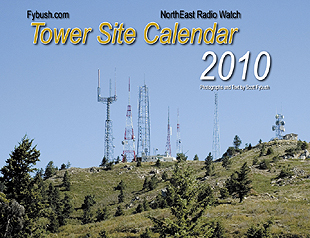 (It's
more than just pretty pictures and dates - the modest sum we
raise from each year's calendar helps make possible the travel
needed to make this feature happen every week on the website...and
we're grateful for all your support!)
(It's
more than just pretty pictures and dates - the modest sum we
raise from each year's calendar helps make possible the travel
needed to make this feature happen every week on the website...and
we're grateful for all your support!)
- Previous Site of the Week: NPR and WAMU, Washington, DC
- Next Week: Carlisle, PA
- Site of the Week INDEX!
- How can you help support Site of the Week? Click here!
- Submit your suggestions for a future Site of the Week!
